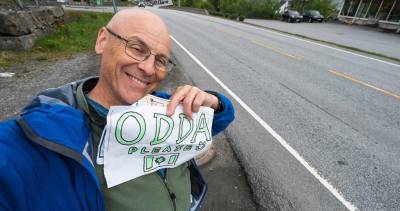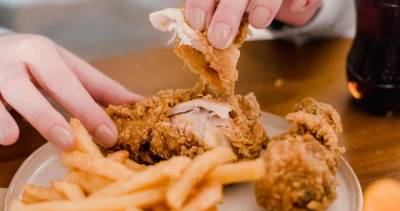Time for a truce in our annual war with the Vancouver crows
Two local residents who understand the quirky birds better than most say they see attitudes changing
Early May can be a magical time in Vancouver.
It’s finally shirtsleeve weather but not summer hot. Residents have been enjoying weeks of showy pink and white cherry and plum blossoms, whose petals are now carpeting the sidewalks and lawns. Gardens are getting started, and tulips are blooming everywhere.
Then, just when people are getting lulled into a seasonal stupor, usually around mid- to late May, the crow attacks start.
Screeching, jet-black feathered divebombers harass people walking down shady sidewalks on their way to the neighbourhood store or just out for a stroll and some fresh air.
Usually, the warning assault results in nothing more damaging than a peck to the back of the head or neck, with feelings more bruised than flesh.
Nonetheless, local TV stations, newspapers, and blogs report on the frenzied actions of both “vicious” birds and their human “victims”. It’s all rather comical—and very predictable.
What some people call “attack season” ornithologists and birders call “nesting season”. It happens every year, sometimes a little later or earlier than the year before, but always in May and June, sometimes into early July. And the crows’ behaviour, of course, is entirely instinctive: they are protecting their young from a perceived threat. Meaning you.
There’s never any shortage of factual reporting to balance the sensational stories, yet there also appears to be no shortage of residents who seem to take the crows’ defensive antics personally. Some appear to be scared, a few even terrified. Bird attacks seem to stir a primal fear in many people, perhaps because of their sudden nature and the fact that the ambush comes from above, and usually from behind. This might be one of the reasons that director Alfred Hitchcock’s masterful 1963 shocker, The Birds, consistently ranks as one of the scariest movies ever made.
For some reason, the annual annoyance seemed to grab Vancouver’s attention in a big way around 2015 or so. It might be no coincidence that in 2016, a Langara College continuing-studies instructor, Jim O’Leary, developed an interactive online map called CrowTrax, where anyone could mark an “attack” wherever it happened in the city.
According to a Guardian 2018 interview with Leary, the map attracted about 1,000 users its first year, and 1,500 in the second. He claimed to have gotten 100 reports in just six hours one day. “It’s become a therapy for people…people just need to tell their story,” he told the paper.
Two Vancouverites would love to see the city’s population just learn to live with and appreciate crows for the fascinating animals that they are: highly intelligent and gregarious birds that have adapted extremely well to human environments.
Rob Butler is an ornithologist and SFU adjunct professor who has been studying birds for more than a half-century. He wrote his master’s thesis on the social organization of crows living on a small island in the Strait of Georgia, and he has been interviewed dozens of times about crow aggression and the famous crow roost in Burnaby’s Still Creek area.
June Hunter is a photographic artist who lives in East Vancouver and is, by her own admission, almost obsessed with crows, along with its close relative, the raven. Besides writing about them on her blog, snapping endless pictures, and fashioning jewellery with their images, she takes frequent walks near her home to check in with the latest developments in the lives of the crows that she has named and that recognize her.
In a phone interview with the Straight, Butler said he thinks that locals are finally warming up to their feathered neighbours, and he is hopeful that the trend will continue and result in some kind of longterm truce, or perhaps even respect.
“People hated them,” he said of feelings about crows in the 1970s. “But there has been a remarkable change in their attitude.”
He attributes that change, in part, to scientific research, and he notes that people started being turned away at some talks and lectures he gave about crows—sometimes hundreds of people.
“Gradually, science is changing all those attitudes,” he said. “Everybody seems to have a story about a crow, because we all interact with them. The crows are the most obvious wild animal in the city.”
He also gives a lot of credit to the remarkable story of a local legendary crow called Canuck that rocketed to international fame in 2016 after news hit wire services about it attempting to make off with a knife from an East Vancouver crime scene. The much-loved bird’s antics had already been regularly featured on local newscasts and in articles and blogs, and when it disappeared in 2019, a $10,000 reward was offered for its return.
“It just shows how popular these animals are,” Butler said. “I think this is all very beneficial.
“Crows are now the poster child of Vancouver.”
For her part, Hunter—who has given names such as Mavis, Mabel, George Brokenbeak, Marvin, and Mr. and Mrs. Walker to several neighbourhood crows—said these birds would fascinate people if they only took time to learn about them.
“They are so easy to watch and they have such personality,” she told the Straight by phone. “You would be a happier person if you could learn to be curious about what is going on…to understand the nesting season.”
Hunter said those who make the effort to read her blog articles or books about crows have told her how their feelings have changed. “People say, ‘Oh, my god, I used to be scared of crows, but they’re so interesting.’ ”
Watching and understanding crows and their personalities is an important part of Hunter’s life now, she said, likening her frequent observations to “watching Netflix…or listening to a radio show that you haven’t tuned into for a while”.
“It just gives me a focus for my life.”
Both Butler and Hunter said Vancouverites need to see that when crows swoop at passersby, they are merely defending their fledglings during a vulnerable couple of weeks after hatching. “They’re terrified that something will happen to their child,” Hunter said.
Butler said that “if the young weren’t there, they wouldn’t be doing it…They’re just doing what you would do as a parent.”
The simplest way to prevent such seasonal attacks? Hunter and Butler are both in agreement again on that score: wear a hat or carry an umbrella when you walk through a nesting crow’s territory.
“Just wait; it will all pass,” Butler added.
And Hunter offered some perspective about crows for fellow Vancouverites: “They’re not perfect. You have to accept that they will do their kind of thing.”















Comments